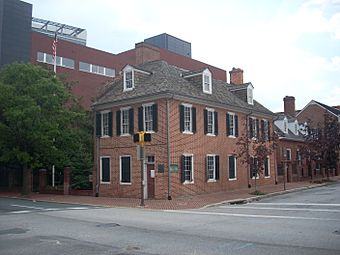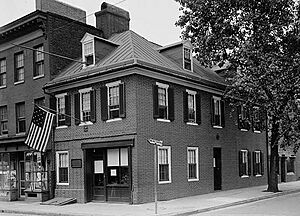- This page was last modified on 17 October 2025, at 10:18. Suggest an edit.
Flag House & Star-Spangled Banner Museum facts for kids
|
Star-Spangled Banner Flag House
|
|

Star-Spangled Banner Flag House in 2011
|
|
| Location | 844 East Pratt Street at Albemarle Street, Baltimore, Maryland, U.S. |
|---|---|
| Built | 1793 |
| Architectural style | Federal style |
| NRHP reference No. | 69000320 |
| Significant dates | |
| Added to NRHP | December 3, 1969 |
| Designated NHL | December 16, 1969 |
The Star-Spangled Banner Flag House is a special museum in Baltimore, Maryland. It's famous because it was once the home of Mary Young Pickersgill. She was the person who sewed the giant "Star-Spangled Banner" flag.
This huge flag flew over Fort McHenry during the War of 1812. In 1814, British ships attacked Baltimore. The flag flying proudly over the fort inspired Francis Scott Key to write the poem that became our national anthem. The house was built in 1793. Mary Pickersgill moved there in 1806.
Today, the museum shows what life was like during the Federal period. You can see furniture and items that belonged to the Pickersgill family. There's also a newer museum building behind the house. It has exhibits about the War of 1812 and the Battle of Baltimore.
Inside the new museum, you'll find an orientation theater and gift shop. There are also galleries with more exhibits. A huge window, 30-by-42-foot (9.1 by 12.8 m), is a replica of the original flag. It has 15 stars and 15 stripes, just like the one Mary Pickersgill made. Outside, there's a map of the United States made from stones. Each stone comes from the state it represents.
Contents
The Flag House After Mary Pickersgill
How the House Became a Museum
After Mary Pickersgill lived there, the house was used for different things. It was a post office, a bank, and even a shipping office. In 1927, the City of Baltimore bought the house. A group called the Star-Spangled Banner Flag House Association helped make it a museum.
In 1928, the house was officially called a historic shrine. This meant it was a very important place in American history. People wanted to make sure its story was remembered.
Saving and Restoring the Flag House
Making the House Look New Again
More work to fix up the house started in 1952. Mayor Thomas J. D’Alesandro, Jr. helped lead these efforts. He grew up nearby and cared a lot about the house. The plan was to restore the house to how it looked when Mary Pickersgill lived there. They even wanted to add replica furniture from that time.
Money for this project came from city funds and donations. The Daughters of the American Revolution gave a lot of money. There was even an idea in 1946 to move the house to Fort McHenry. But that plan didn't happen.
Protecting History Amidst Change
As the Flag House was being restored, the area around it was changing. There were plans to build a new highway, Interstate 95. Some people worried this new road would harm the historic feel of nearby neighborhoods. These areas included Federal Hill and Fells Point. They felt new construction might take away from the old charm of the historic site.
In 1969, the house was named a National Historic Landmark. This is a special title given to places important to American history. It helps protect these sites for future generations.
Patriotism and the Flag House
A Place for National Pride
Throughout its history, the Flag House has been a place for showing national pride. Many ceremonies and speeches have happened there. These events often focused on American patriotism and the importance of the flag.
In June 1955, a ceremony celebrated National Flag Week. A retired general, Brigadier General Bonner Fellers, spoke about the need for a strong military. He also talked about protecting American independence.
In June 1961, a dedication ceremony took place for the stone map outside. Representative Gordon L. McDonough spoke to a crowd of 375 people. He encouraged a return to "good old-fashioned American patriotism." He also wanted Flag Day to become a national holiday.
"Pause for the Pledge" Campaign
In May 1980, the Flag House launched a national campaign. They asked all Americans to "Pause for the Pledge" on Flag Day. This idea became very popular. In June 1985, President Ronald Reagan signed a law supporting this. It recognized the "Pause for the Pledge of Allegiance" as part of National Flag Day activities. This shows how the Flag House continues to inspire national unity.

